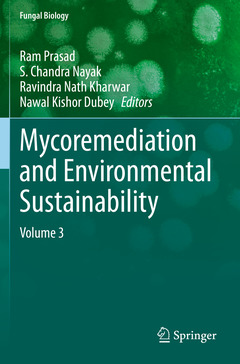Preface
Chapter 1: Bioremediation of Toxic Pesticides in Soil Using Some Microbial Products
O.P. Abioye, Department of Microbiology, Federal University of Technology P. M. B 65 Minna, Nigeria
U.J.J. Ijah, Department of Microbiology, Federal University of Technology P. M. B 65 Minna, Nigeria
S.A. Aransiola, Bioresources Development Centre, National Biotechnology Development Agency, KM 5 Ogbomoso/Iresapa Road, Onipaanu, Ogbomoso, Nigeria
S.H. Auta, Department of Microbiology, Federal University of Technology P. M. B 65 Minna, Nigeria
Chapter 2: Microbial Enzymes in the Bioremediation of Polutants: Emerging Potential and Challenges
Geeta Bhandari, Department of Biochemistry and Biotechnology, SBS University, Dehradun, UK, 248001
Mukund Sharma, Department of Biochemistry and Biotechnology, SBS University, Dehradun, UK, 248001
Chapter 3: Arbuscular Mycorrhizal Fungi and Remediation Potential of Soils Contaminated by Potentially Toxic Elements
Laíze Aparecida Ferreira VILELA, Federal University of São Carlos, São Paulo, Brazil
Edenis Cesar de OLIVEIRA, Federal University of São Carlos, São Paulo, Brazil
Chapter 4: Nanotechnology and Bioremediation
Ranju Sharma, Department of Zoology, University of Delhi, Delhi-110007, India
Ngangbam Sarat Singh, Department of Zoology, Dr. SRK Government Arts College, Yanam – 533464 Puducherry (UT)
Neha Dhingra, Department of Zoology, University of Delhi, Delhi-110007, India
Sonal Yadav, Centre for rural development and technology, IIT-Delhi, HauzKhas, New Delhi-110016, India
Mohd. Aamir Khan, Centre for rural development and technology, IIT-Delhi, HauzKhas, New Delhi-110016, India
Chapter 5: Mycoremediation through Redox Mechanisms of Organic Pollutants
Refugio Rodríguez-Vázquez, Department of Biotechnology and Bioengineering. CINVESTAV. Instituto Politécnico Nacional, México. Av. Instituto Politécnico Nacional No. 2508. Col. San Pedro Zacatenco, México CP 07360. México
Edgar N. Tec-Caamal, Department of Biotechnology and Bioengineering. CINVESTAV. Instituto Politécnico Nacional, México. Av. Instituto Politécnico Nacional No. 2508. Col. San Pedro Zacatenco, México CP 07360. México
Juana Lira-Pérez, Department of Biotechnology and Bioengineering. CINVESTAV. Instituto Politécnico Nacional, México. Av. Instituto Politécnico Nacional No. 2508. Col. San Pedro Zacatenco, México CP 07360. México
Ricardo Aguilar-López, Department of Biotechnology and Bioengineering. CINVESTAV. Instituto Politécnico Nacional, México. Av. Instituto Politécnico Nacional No. 2508. Col. San Pedro Zacatenco, México CP 07360. México
Adriana de J. Ramírez-Castillo, Department of Biotechnology and Bioengineering. CINVESTAV. Instituto Politécnico Nacional, México. Av. Instituto Politécnico Nacional No. 2508. Col. San Pedro Zacatenco, México CP 07360. México
Chapter 6: Role of Endophytes in Plant Associated Remediation and Plant Growth Promotion: A Deep Insight
Saurabh Gupta, Department of Microbiology, Mata Gujri College, Fatehgarh Sahib-140406, India
Gaganpreet Kaur, Department of Biotechnology & Medical Sciences, Baba Farid Group of Institutions, Baba Farid College, Bathinda, India
Chapter 7: Microbial Remediation: A Natural Approach for Environmental Pollution Management
Vankayalapati Vijaya Kumar, Natems Sugar Private Limited, Plot No.13, House of Shalom, 2nd Floor, Greenland Colony, Gachibowli, Hyderabad -500032, Telangana State, India
Chapter 8: Microbial Biocontrol Agents for Agricultural Soil Remediation: Prospects and Application
Yit Kheng Goh, School of Science, Monash University Malaysia, Jalan Lagoon Selatan, 47500 Bandar Sunway, Selangor Darul Ehsan, Malaysia; Advanced Agriecological Research Sdn. Bhd., No. 11, Jalan Teknologi 3/6, Taman Sains Selangor 1, Kota Damansara, 47810 Petaling Jaya, Selangor Darul Ehsan, Malaysia
Adeline Su Yien Ting, School of Science, Monash University Malaysia, Jalan Lagoon Selatan, 47500 Bandar Sunway, Selangor Darul Ehsan, Malaysia
Chapter 9: Soil Bioremediation: An Insight into Available Green Technology and Future Developments
Zeenat Khan, Environmental genomics and proteomics laboratory, BRD School of Biosciences, Sardar Patel University, Vallabh Vidyanagar, Anand-388120, Gujarat, India
Arun Kalia, Department of Environmental Science and Technology Central University of Punjab Bathinda-151001, India
Ravi Kant Bhatia, Department of Biotechnology Himachal Pradesh University, Summer Hill, Shimla-171 005 (H.P.) India
Chapter 10: Microbial Bioformulation Technology for Applications in Bioremediation
Jia May Chin, School of Science, Monash University Malaysia, Jalan Lagoon Selatan, 47500 Bandar Sunway, Selangor, Malaysia
Adeline Su Yien Ting, School of Science, Monash University Malaysia, Jalan Lagoon Selatan, 47500 Bandar Sunway, Selangor, Malaysia
Chapter 11: Endophytic Fungi Interaction with Transgenic Plants
Deepak Kumar, Department of Botany, Central University of Jammu, Rahya-Suchani (Bagla), District- Samba-181143, Jammu (Jammu & Kashmir), India
Chapter 12: Mycoremediation of Plastics for Efficient Waste Management: A Review
Sherry Davis A., Department of Environmental Biotechnology, School of Environmental Sciences, Bharathidasan University, Tiruchirappalli – 620 024, Tamil Nadu, India
V. Veeramani, Department of Environmental Biotechnology, School of Environmental Sciences, Bharathidasan University, Tiruchirappalli – 620 024, Tamil Nadu, India
B. Gowri Manogari, Department of Environmental Biotechnology, School of Environmental Sciences, Bharathidasan University, Tiruchirappalli – 620 024, Tamil Nadu, India
Thamaraiselvi K., Department of Environmental Biotechnology, School of Environmental Sciences, Bharathidasan University, Tiruchirappalli – 620 024, Tamil Nadu, India
Chapter 13: Biotechnology of Beneficial Bacteria and Fungi Useful in Agriculture
Sandra Pérez Álvarez, Facultad de Ciencias Agrícolas y Forestales, Universidad Autónoma de Chihuahua, Km 2.5, carretera Delicias-Rosales, campus Delicias, CD. Delicias, Chihuahua CP 33000
Eduardo Fidel Héctor Ardisana, Instituto de Posgrado, Universidad Técnica de Manabí, Portoviejo, Ecuador, CP EC130105
Index




